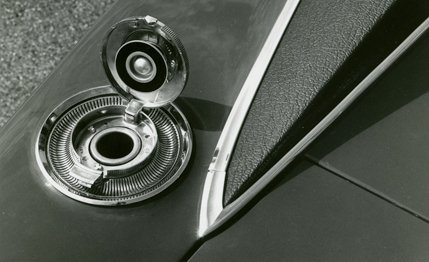The interior of the Charger carries the GT theme further, with bucket seats, map pockets in the doors, and a well-padded dash with a full complement of instruments set in a matte black background. The tachometer and speedometer are directly in front of the driver while the smaller engine instruments are to the right of the driver, but angled towards him.
With all this performance image going for the Charger, we just had to order an engine to go with it—and when you’re talking a Chrysler product, the performance engine is the Hemi. There just isn’t more honest horsepower available off the showroom floor than you get from this bright orange monster. While there are larger displacement engines to be had (Dodge offers a 440 cu. in. V-8 option for the Charger for less money than the 426 cu. in. Hemi), none of them can be had with two 4-barrel carburetion.
The Hemi, despite its high performance carburetion, comes very close to meeting smog control regulations without any modifications, hence, has had only minor alterations to the carburetor and distributor calibrations to meet the new laws. The carburetors feed the hemispherical combustion chambers through huge ports and 2.25-in. intake valves with thin (.309-in.) stems, all calculated to put as much fuel/air mixture in the Hemi as possible. The exhaust system is as efficient, with 1.94-in. valves, thin stems, and cast headers leading to a 2.5-in. dual exhaust system.
The rest of the Hemi is just as tough, with cross-bolted caps for three of its five main bearings; a specially heat-treated, forged steel crankshaft; big, husky connecting rods; forged domed pistons; solid lifters and heavy duty pushrods; and a dual-breaker distributor—in short, a racing engine. And that’s what it was originally designed for.
When Chrysler decided to sell the Hemi as an option, they found it was cheaper to carry over the racing parts into production, in most cases, than to tool up for cheaper, street parts. For all-out competition, about all you need is the high compression pistons (same basic design, but more pop-up), a longer duration camshaft, and a set of tubular headers. For stock car racing, there is a very special “ram-tuned” intake manifold and a giant Holley 4-bbl. carb.
|
|
Our “street” Hemi was more than powerful enough for any use an ordinary citizen might find. Rated conservatively at 425 hp and 490 lbs./ft. of torque, the Hemi propelled the Charger through the quarter-mile traps at just over 105 mph, covering the distance in 13.5 seconds—not bad for 4346 lbs. test weight, and a “cooking” engine. The drag racers buy a 500-lb. lighter 2-door sedan, and do some of the tuning we mentioned above, to go through the traps at close to 130 mph—just in case you had any doubts about our engine being in street tune.
Some of you may have had a Hemi before, and may have experienced some problems with it, particularly in the area of oil consumption. For 1968 the Hemi has undergone some changes to fix this problem and to insure against some others. New valve stem oil seals have cured the oil consumption problem, an oil pan windage tray has permitted the addition of an extra quart of oil to the sump to make sure that the oil pick-up never sucks air, and a fuel vapor separator has been added to the fuel line to prevent vapor lock (which can make hot starts difficult). A slightly longer duration camshaft is also new. Although the peak rating hasn’t changed since 1967, the new cam improves the shape of the power curves. We suspect, however, that the camshaft and the windage tray are responsible for the Charger’s extra one mph at the end of the quarter-mile, compared to the Plymouth Hemi Satellite we tested in April, 1966.
The Satellite we tested was a 4-speed manual, and we remarked at the time that we’d rather have had an automatic, so we ordered our Charger with one. We were right; the automatic is the plan. Driving through the special high-stall-speed torque convertor which comes with the Hemi, you can either shift manually, winding the Hemi right out to 6500 rpm, or leave it in Drive, where the TorqueFlite shifts for you at about 5500 rpm. If you keep your foot in it that long, the 2-3 shift has you doing well over 90 mph. If you cool it, the automatic lets you drive the Hemi like the 230-hp, 318 cu. in. (standard equipment for the Charger). It would take a fairly sharp mother-in-law to suspect that you had anything but the most docile of powerplants underneath the hood.
We were prepared to not like the brakes on our Charger, as the brakes on Chrysler’s “B” body cars have previously fallen short of our standards, but things have changed. We ordered the disc brake option, wanting all the stopping power we could get to go with the Hemi’s go power, and found the brakes to be very satisfactory. Directional stability was good, and our stopping distances were right around 274 ft. (.78 G), a perfectly acceptable figure, considering the mass of the car. We did encounter fade once, early in our braking tests, which we attributed to “green fade,” a phenomenon that new brake pads go through once before they settle down. Afterwards, we experienced no fade in five successive panic stops from 80 mph.
View Photos
View Photos


Leave a Reply